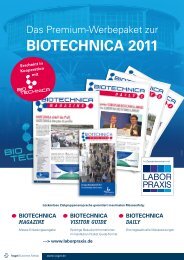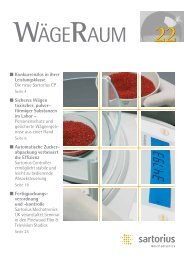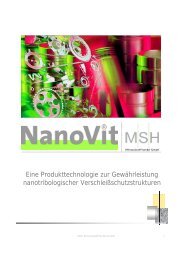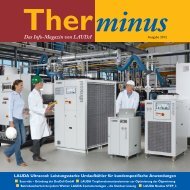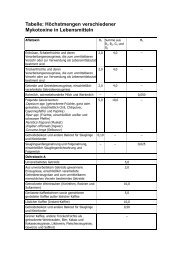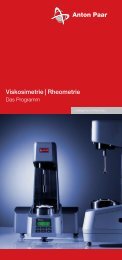Clean, Fast Organic Chemistry - LaborPraxis
Clean, Fast Organic Chemistry - LaborPraxis
Clean, Fast Organic Chemistry - LaborPraxis
You also want an ePaper? Increase the reach of your titles
YUMPU automatically turns print PDFs into web optimized ePapers that Google loves.
Sample Edition
<strong>Clean</strong>, <strong>Fast</strong> <strong>Organic</strong> <strong>Chemistry</strong><br />
By Nicholas Leadbeater, Ph.D. and Cynthia McGowan, Ph.D.<br />
Sample Edition
ii<br />
Copyright 2006 by CEM Publishing<br />
All Rights Reserved<br />
The information furnished by CEM Corporation is proprietary information that shall not be<br />
reproduced or transferred to other documents or disclosed to others without prior written<br />
permission of CEM Corporation.<br />
CEM ® is a registered trademark of CEM Corporation.<br />
Discover ® is a registered trademark of CEM Corporation.<br />
Teflon ® is a registered trademark of the E.I. DuPont Company.<br />
MARS, BenchMate, SafeSeal, LabMate, IntelliVent, RTP 300 Plus, ESP-1500 Plus,<br />
HP-500 Plus, XP-1500 Plus and GreenChem are trademarks used by CEM Corporation for<br />
product identification.<br />
The Discover ® Focused Microwave Synthesis System is protected under US Patent No. 6,630,652<br />
The MARS Microwave Accelerated Reaction System is protected under the following US Patent<br />
Nos. – RE34,373, 4,877,624, 5,3689,034, 4,835,354, 5.206,479, 5,427,741, 4,672,996, 5,230,865 and<br />
5,520,886<br />
The HP-500 Plus vessel and its design are protected under the following U.S. Patent Nos. –<br />
5,427,741 and 5,369,034<br />
Patents Pending<br />
Printed in USA<br />
Student Edition:<br />
ISBN-10: 0-9722229-3-6<br />
ISBN-13: 978-0-9722229-3-8<br />
Instructor’s Edition:<br />
ISBN-10: 0-9722229-4-4<br />
ISBN-13: 978-0-9722229-4-5<br />
Cover design by Rich Davis<br />
Illustrations by Steve Smith<br />
CEM Publishing<br />
PO Box 200<br />
Matthews, NC 28106<br />
800-726-3331
<strong>Clean</strong>, <strong>Fast</strong> <strong>Organic</strong> <strong>Chemistry</strong><br />
By Nicholas Leadbeater, Ph.D. and Cynthia McGowan, Ph.D.<br />
Sample Edition<br />
Table of Contents<br />
Foreword........................................................................................................................................v<br />
Chapter 1 - The Fundamentals of Microwave Heating........................................................1<br />
Chapter 2 - Microwaves in <strong>Organic</strong> <strong>Chemistry</strong> ...................................................................11<br />
Chapter 3 - Equipment and Safety .........................................................................................23<br />
Experiment 1 - Nucleophilic aromatic substitution............................................................41<br />
Experiment 2 - Esterification ...................................................................................................51<br />
Experiment 3 - Diels-Alder reaction ......................................................................................61<br />
Experiment 4 - Suzuki coupling .............................................................................................69<br />
Experiment 5 - Williamson ether synthesis..........................................................................81<br />
Experiment 6 - Intramolecular aldol condensation.............................................................87<br />
Experiment 7 - Hydrolysis of a nitrile ...................................................................................93<br />
Experiments 8-11 - Multi-step synthesis of stilbene from benzaldehyde......................99<br />
Experiment 8 - Knoevenagel condensation.............................................................101<br />
Experiment 9 - Bromination.......................................................................................107<br />
Experiment 10 - Elimination reaction.......................................................................115<br />
Experiment 11 - Preparation of stilbene from 1-bromo-2-phenylethene..........127<br />
References..................................................................................................................................135<br />
Index ...........................................................................................................................................139
Chapter<br />
1<br />
Spencer also tried cooking an<br />
egg using microwave energy.<br />
Though the experiment<br />
succeeded, the egg<br />
unfortunately exploded in the<br />
face of a co-worker.<br />
Reactions that took more than<br />
8 hours to complete were<br />
performed in just a few<br />
minutes using a microwave.<br />
The Fundamentals of Microwave Heating<br />
History<br />
Most people think of a microwave as a convenient way to pop popcorn or reheat<br />
leftover pizza, but relegating this technology to the kitchen deprives chemists of<br />
one of the most useful laboratory tools of the past 20 years. Microwave energy is a<br />
very efficient means of driving chemical reactions. Just as in a kitchen microwave,<br />
water boils much quicker than putting it in a pot on a stove: chemical reactions<br />
proceed significantly faster in an industrial microwave than on a hotplate or in a<br />
steam bath. The speed at which these reactions occur can lead to increased product<br />
yields and cleaner chemistries, enabling chemists to perform in minutes reactions<br />
that used to take hours, or even days, to complete.<br />
Microwave energy was first utilized in the early 1940s in radar equipment to<br />
detect and map objects. Then, in 1946, Percy Spencer, an employee of Raytheon<br />
Corporation, noticed that a candy bar in his pocket had melted while he was<br />
working on a radar system. Intrigued by this phenomenon, he brought in some<br />
popcorn and found that if he placed it near his radar equipment, it popped.<br />
Raytheon patented the microwave cooking process and in 1947, introduced the<br />
first Radarange, which was almost six feet high and weighed over 750 pounds.<br />
The first commercially successful model came out in 1967.<br />
In the 1980s, chemists began using microwave energy to perform acid digestions<br />
and to speed up solvent extractions. During the next decade, microwave sample<br />
preparation became a widely accepted method, though there are only scattered<br />
references of chemists using the technology for organic synthesis at that time. The<br />
concept of performing reactions in short periods of time with this advanced energy<br />
source was starting to take hold, but was not yet fully mature, due in large part to<br />
issues with equipment.<br />
Traditionally, organic chemists heat their reaction mixtures on a hotplate or in an oil<br />
or hot water bath. These are relatively slow and inefficient ways of transferring heat<br />
to a sample because they depend on convection currents and the thermal conductivity<br />
of the reaction mixture. The walls of the reaction vessel can also be hotter than the<br />
contents, which can result in the decomposition of reagents or products over time.<br />
The first reports of the use of microwave heating for organic chemistry came in<br />
1986. Two research teams published results they had obtained in their laboratories<br />
using simple domestic (kitchen-type) microwave ovens. They found that the<br />
reactions they studied were complete much faster when they used the microwave<br />
oven compared to when they used a hotplate. Since the energy interacts with the<br />
sample on a molecular level, microwave irradiation is a very efficient method for<br />
heating a reaction mixture. Microwave laboratory systems built specifically for<br />
organic synthesis have improved greatly since the end of the 20th century and<br />
now offer chemists a faster, easier-to-use, and safer alternative to conventional<br />
methods.<br />
1
2<br />
Hertz: Unit of measurement<br />
of frequency, numerically<br />
equal to cycles per second.<br />
The energy of a microwave at<br />
a frequency of 2.45 GHz is<br />
0.0016 electron volts (eV).<br />
The average energies of some<br />
common chemical bonds are<br />
as follows:<br />
C-C single bond = 3-4 eV<br />
C=C double bond = 6-7 eV<br />
O-H bond = 4-5 eV<br />
Microwave Energy<br />
Microwave irradiation is a form of energy that falls between 300 and 300,000<br />
megahertz (MHz), relatively low on the electromagnetic spectrum. (Figure 1)<br />
Unlike ultraviolet radiation, which is used in photochemistry and can break<br />
chemical bonds, microwaves are low frequency forms of energy that only cause<br />
the molecules to rotate.<br />
Figure 1. The electromagnetic spectrum<br />
Like all electromagnetic energy, microwaves move at the speed of light and are<br />
comprised of oscillating electric and magnetic fields. (Figure 2) These fields swing<br />
back and forth at right angles to each other, perpendicular to the source of the<br />
energy. It is primarily the electric field of the microwave which interacts with molecules<br />
and causes the transfer of energy and the generation of heat.<br />
Figure 2. A microwave
The combination of the two<br />
heating mechanisms can be<br />
seen when considering a sample<br />
of water. Salt water heats<br />
much faster in a microwave<br />
than distilled water. This is<br />
because only the dipolar<br />
polarization mechanism is<br />
operative in distilled water,<br />
whereas salt water contains<br />
ions and makes use of both<br />
mechanisms.<br />
How Microwaves Accelerate Chemical Transformations<br />
There are two ways in which microwaves can heat substances: dipolar polarization<br />
and ionic conduction. If a molecule possesses a dipole moment, it tries to<br />
align with the electric field of the microwave. Since the electric field is oscillating,<br />
the dipoles constantly try to realign to follow it. At 2.45 GHz, molecules have time<br />
to align with the electric field, but not to follow the oscillating field exactly. This<br />
continual re-orientation of the molecules results in friction, and thus heat. This<br />
heating method is termed dipolar polarization. (Figure 3)<br />
Figure 3. Molecule movement as affected by dipolar polarization<br />
If a molecule is charged, then the electric field component of the microwave<br />
moves the ions back and forth through the sample. This movement generates heat<br />
and is known as ionic conduction. (Figure 4)<br />
Figure 4. Molecule movement as affected by ionic conduction<br />
Compared to using a hotplate to heat a reaction mixture, microwave irradiation is<br />
much more efficient and greatly reduces the reaction time. The hotplate relies on<br />
thermal conductivity and convection currents to heat the reaction mixture. That<br />
energy must first heat the vessel containing the reaction mixture, and then pass<br />
through to the reactants. Microwave energy interacts directly with the molecules<br />
in the reaction mixture, heating the reactants much faster than conventional<br />
3
4<br />
Microwave heating is<br />
significantly more efficient<br />
than conventional heating.<br />
About 80% of the power<br />
consumed by a microwave<br />
oven is used to heat food<br />
compared to as little as 10%<br />
for conventional ovens.<br />
The Arrhenius equation is a<br />
simple, yet very accurate<br />
predictor of the reaction rate.<br />
methods. With microwave irradiation, since the energy is interacting with the<br />
molecules at a very fast rate, the molecules do not have time to relax and the heat<br />
generated can be, for short times, much greater than the overall recorded temperature<br />
of the bulk reaction mixture. In essence, there will be instantaneous localized<br />
superheating. (Figure 5)<br />
Figure 5. Localized superheating of molecules in solutions<br />
The rate of a reaction is described by the Arrhenius equation, which expresses the<br />
relationship between the rate of reaction and the activation energy, E a. (Figure 6)<br />
Figure 6. Arrhenius equation<br />
The activation energy is the energy barrier that must be overcome in order for the<br />
reaction to occur. A microwave transfers energy to the reaction every nanosecond<br />
(10 -9 seconds). The almost constant energy input is achieved at a rate greater than<br />
the molecular relaxation rate, which is on the order of 10 -5 seconds. Because the<br />
energy is added at a rate faster than the molecules are able to relax, all of the<br />
molecules in solution will be in a constant state of disequilibrium, providing more<br />
than enough energy to overcome the activation energy barrier (E a) and drive the<br />
reaction to completion. (Figure 7)
Figure 7. Reaction coordinate<br />
When performing a reaction using microwave heating compared to conventional<br />
hotplate heating, the only factor in the Arrhenius equation that is affected is the<br />
temperature value. It is important to remember that the activation energy and the<br />
pre-exponential factor (defined as the frequency of collisions between molecules<br />
that have the correct geometry for a reaction to occur) are not affected. They are<br />
defined by the type of reaction and the nature of the substrates and are the same<br />
regardless of how the reaction is heated.<br />
Consider a simple reaction with an activation energy of 200 kJ mol -1 performed at<br />
150 °C. In order to get a 10-fold rate enhancement, it would only be necessary to<br />
increase the temperature by 17 °C, and for a 1,000-fold rate enhancement by 56 °C.<br />
k=Ae –E a /RT<br />
Looking at a reaction with E a = 200 kJ mol -1 .<br />
Temp/ °C Relative rate<br />
150 1<br />
167 10<br />
185 100<br />
206 1,000<br />
These elevated temperatures can easily be obtained by instantaneous localized<br />
superheating caused by the input of microwave energy, which also explains the<br />
enhanced reaction rates seen in chemical reactions when using microwave heating<br />
as opposed to a hotplate or any other conventional method.<br />
Microwave Energy & Solvents<br />
Every solvent or reagent used in a reaction will interact with microwave energy<br />
differently. Although not the only factor in determining the absorbance of<br />
microwave energy, the polarity of the solvent is a helpful tool for ascertaining how<br />
well it will heat when placed in a microwave field. A solvent that is more polar will<br />
have a stronger dipole trying to align with the movement of the electric field, causing<br />
more rotational movement, and thus, heat. A non-polar solvent or substance does<br />
not absorb as much energy because it is not as disturbed by changes in the<br />
microwave field. Hence, the non-polar solvent generally does not heat as well as<br />
the polar.<br />
5
6<br />
A common misconception is<br />
that the frequency used in<br />
microwave ovens was chosen<br />
because it is absorbed well by<br />
water. In fact, at 2.45 GHz,<br />
water is only a medium<br />
absorber. The practical reason<br />
for using this frequency for<br />
domestic microwaves is that it<br />
is important to heat food<br />
efficiently throughout. If the<br />
frequency were changed to<br />
produce the maximum heating<br />
rate, the microwave would<br />
heat very unevenly.<br />
Solvents can be split in to three categories: those that absorb microwaves well,<br />
moderately, and poorly. High absorbing solvents will heat up very fast when<br />
exposed to microwave energy. Lower absorbing solvents can still be used, but they<br />
work better if one of the reagents in the reaction mixture is a good absorber.<br />
Figure 8. Examples of absorption of microwave energy by various solvents<br />
Making Microwaves<br />
Microwaves are generated using a device known as a magnetron. This consists of<br />
a hot filament (cathode) built into the center of a circular sealed vacuum chamber<br />
and held at a high negative potential. A perpendicular magnetic field is imposed<br />
by a permanent magnet. The magnetic field causes the electrons, attracted to the<br />
positive outer part of the chamber, to spiral outward in a circular path rather than<br />
move in a straight line. This creates a rotating electron cloud around the tube axis.<br />
There are vanes attached to the inside surface of the chamber. As electrons sweep<br />
past these vanes, they induce a resonant high frequency radio field in the chamber,<br />
which in turn, causes the electrons to bunch into groups. A portion of this field is<br />
extracted from the chamber with a short antenna that is connected to a metal tube<br />
called a waveguide. The waveguide directs the extracted energy into the cavity<br />
(heating chamber) of the microwave oven. (Figure 9)<br />
Figure 9. Vacuum chamber and magnetron
If a reaction vessel were to<br />
explode in a domestic<br />
microwave, it could cause<br />
significant damage and even<br />
worse, injury.<br />
Reactions have been performed<br />
in vessels up to 5 liters in<br />
capacity, using multimode<br />
microwave systems like the<br />
one pictured.<br />
In domestic microwave ovens, known as multimode systems, the microwaves<br />
move through the waveguide, enter the cavity, and then bounce off the cavity<br />
walls. As they do so, they generate pockets (called modes) of high energy and low<br />
energy as the moving waves either reinforce or cancel each other out. (Figure 10)<br />
This means that the microwave field in the cavity is not uniform. Instead, there<br />
will be hot spots and cold spots corresponding to the pockets of high and low<br />
energy respectively.<br />
Figure 10. Microwave modes. Areas of high energy and low microwave energy<br />
are found in the cavity.<br />
While much of the early work in microwave synthesis was performed in simple<br />
domestic ovens, there are some serious problems in using them for chemistry. First<br />
and foremost, they are not designed for the containment of organic solvents and<br />
reagents, and are, therefore, unsafe for this use. It is also not possible to accurately<br />
measure the temperature of a reaction or precisely control the power. Most reactions<br />
were performed in sealed tubes or in open flasks using polar solvents or an additional<br />
substance, such as a highly microwave absorbing inert support. In addition, the<br />
walls of most domestic ovens are not made to industrial standards. The walls will<br />
flex during heating causing changes in the positions of the modes of microwave<br />
energy and resulting in unstable heating fields.<br />
Multimode microwave apparatus designed for use in preparative chemistry has<br />
been developed. In addition to being designed to withstand overpressurizations of<br />
reaction vessels inside the microwave cavity, these systems also have temperature<br />
and pressure monitoring and the ability to stir reaction mixtures. It is possible to<br />
run a number of reactions at the same time in a multimode microwave oven: the<br />
samples are placed into sealed vessels and loaded onto a turntable. Rotation of the<br />
vessels through the microwave field causes them to absorb the microwave energy<br />
more effectively. Heating is largely uniform due to both the movement of the<br />
turntable and the larger size of the vessels. (Figure 11)<br />
Figure 11. Reaction vessels move through modes of high and low energy in a<br />
microwave cavity.<br />
7
8<br />
There is more power per cm 3 in<br />
a monomode apparatus than in<br />
a multimode, due to the size of<br />
the cavity.<br />
Problems occur when trying to perform reactions on a smaller scale. A single reaction<br />
of a few milliliters is difficult to heat effectively in a multimode microwave apparatus.<br />
This is because, with the hot and cold spots that occur in a multimode cavity, it is<br />
difficult to get constant microwave energy to irradiate the small sample. To overcome<br />
these problems, smaller, single-mode (often called monomode) microwaves have<br />
been developed. The cavity of a monomode microwave system is designed for the<br />
length of only one wave (mode). By placing the sample in the middle of the cavity, it<br />
can be irradiated constantly with microwave energy. (Figure 12) Using a monomode<br />
apparatus, it is possible to heat samples of as little as 0.2 mL very effectively. The<br />
upper volume limit of the monomode apparatus is determined by the size of the<br />
microwave cavity and is in the region of 100 mL.<br />
The cavity of a monomode microwave apparatus<br />
is designed for the length of only one mode.<br />
By placing the sample in the middle of the cavity, it<br />
can be irradiated constantly with microwave energy.<br />
Figure 12. Monomode microwave cavity<br />
The power output of microwaves from a magnetron is measured in watts (W). For a<br />
multimode microwave, power output of up to 1200 W is possible. For monomode<br />
apparatus the maximum power output is only 300 W. At a first glance, it may<br />
seem that the monomode apparatus is much less powerful than its multimode<br />
counterpart; however, the relative size of the cavity needs to be considered.<br />
Multimode microwaves have large cavities, and thus, power is dissipated over a<br />
large area. Monomode equipment has a much smaller cavity and the energy density<br />
is up to 30-40 times higher than the multimode apparatus.<br />
Microwave heating has revolutionized modern preparative chemistry. It is possible to<br />
make molecules rapidly, cleanly, and very efficiently. As well as improving known<br />
reactions, microwave heating is also enabling us to perform new reactions that<br />
were previously not possible or else were very difficult.
Key concepts<br />
Microwave radiation is relatively low in energy. It is non-ionizing and cannot<br />
break chemical bonds. It can only make molecules rotate.<br />
Microwaves are generated by a magnetron, move at the speed of light, and are<br />
comprised of oscillating electric and magnetic fields.<br />
The electric field component of microwave energy interacts with molecules by<br />
way of either a dipolar polarization or ionic conduction mechanism.<br />
Conventional heating is slow, relying on convection currents and thermal conductivity,<br />
whereas microwave heating is fast and occurs on a molecular level.<br />
Domestic microwave ovens are not designed for use in preparative chemistry and<br />
performing reactions in them is unsafe and unreliable.<br />
There are two types of microwave equipment specifically designed for use in<br />
preparative chemistry: multimode and monomode.<br />
Modern multimode and monomode apparatus are safe and reliable: it is possible to<br />
measure and monitor the reaction temperature accurately.<br />
Multimode systems are useful for performing a number of smaller scale reactions at<br />
the same time or one larger scale reaction.<br />
Monomode systems are useful for performing individual, smaller-scale reactions.<br />
The rate enhancement effects of microwave heating can be explained in terms of<br />
instantaneous localized superheating of the reaction mixture and by looking at<br />
the Arrhenius equation.<br />
9
Experiment<br />
1<br />
S N Ar reactions are used on an<br />
industrial scale for the<br />
preparation of pharmaceuticals.<br />
The two-step mechanism is<br />
supported by the isolation of<br />
many Meisenheimer salts.<br />
Evidence for a rate determining<br />
first step comes from the<br />
observation that fluoroaromatics<br />
undergo nucleophilic<br />
substitution much more rapidly<br />
than their iodo- counterparts,<br />
despite the fact that I - is a much<br />
better leaving group than F - .<br />
Thiocyanates are salts and<br />
esters of thiocyanic acid<br />
HSC ≡ N. They are some of<br />
the compounds responsible<br />
for the spicy taste in radishes<br />
and black mustard.<br />
Nucleophilic aromatic substitution<br />
Introduction<br />
Nucleophilic aromatic substitution (S NAr) reactions offer a useful way to functionalize<br />
an aromatic ring. The high π–electron density of an aromatic ring results in<br />
predominant reactivity towards electrophiles; however, if the aromatic ring is activated<br />
with electron withdrawing groups (EWG) ortho and/or para to a good leaving group,<br />
a nucleophilic substitution reaction is possible. Halogens are the most common<br />
leaving groups for S NAr reactions and functional groups such as -NO 2, -SO 2R, -NR 3, -CF 3<br />
and -CN are electron withdrawing enough to render the aromatic ring susceptible<br />
to reaction with an electron-rich nucleophile, such as an amine.<br />
The reaction follows an addition-elimination two-step reaction sequence. It is generally<br />
accepted that the first step, in which a tetrahedral cyclohexadienyl anion called a<br />
Meisenheimer complex is formed, is the rate-determining step (rds). This is generated<br />
by the addition of the nucleophile to the carbon bearing the leaving group.<br />
Subsequent elimination of the halogen substituent (leaving group) leads to regeneration<br />
of the aromaticity in the ring.<br />
In this experiment, one of three nucleophiles (potassium thiocyanate, ethylamine,<br />
or aniline) is used to substitute for the bromine on 1-bromo-2,4-dintrobenzene.<br />
The three possible products from the S NAr with 1-bromo-2,4-dinitrobenzene are<br />
all highly-colored crystalline solids, and are as follows:<br />
11
12<br />
The reactions are run using<br />
ethanol or a water–ethanol<br />
mixture as the solvent. This<br />
makes it a clean reaction and<br />
the product is easy to isolate.<br />
Refer to Chapter 3 for more<br />
detailed instructions on setting<br />
up and safely securing your<br />
HP-500 vessel as well as<br />
information on programming<br />
the MARS System.<br />
Experimental procedure<br />
Microwave Unit: MARS<br />
Procedure for 2,4-dinitrophenyl thiocyanate:<br />
Reagents used:<br />
SAFETY PRECAUTIONS:<br />
1-Bromo-2,4-dinitrobenzene is classified as an irritant. Potassium thiocyanate is<br />
a toxic compound. This reaction should not be attempted in a sealed reaction<br />
vessel without temperature control.<br />
1-Bromo-2,4-dinitrobenzene (0.296 mg, 1.20 mmol), potassium thiocyanate (0.467 mg,<br />
4.80 mmol), ethanol (4.0 mL) and water (1.0 mL) are placed in an HP-500 Teflon ®<br />
microwave reaction vessel containing a magnetic stir bar. NOTE: The final volume<br />
must be at least 5 mL. The reaction vessel is inserted into the protective sleeve, fitted<br />
with the vessel top and load disk, and then placed into the vessel frame. The<br />
pre-set torque wrench is used to tighten the nut on top of the frame before placing<br />
it on the microwave turntable. Note the position the vessel occupies. The reaction<br />
control vessel (position #1) is connected to the temperature thermocouple<br />
and, if applicable, to the pressure sensor. The microwave is programmed using the<br />
ramp-to-temperature method to heat to 125 °C over a 2-minute period and then<br />
held at this temperature for 20 minutes. The solution is then allowed to cool for 5<br />
minutes, or until it is below 50°C before removing from the microwave unit.<br />
CAUTION: The vessel may still be hot to the touch.<br />
The vessel is vented by loosening the blue nut. It is then removed from the frame<br />
and its protective sleeve. The reaction mixture is cooled in an ice bath to initiate<br />
crystallization. Once crystallization is complete, the product can be collected by<br />
vacuum filtration and washed with cold solvent. The brightly colored crystalline
No water is added; ethanol<br />
is the only solvent used.<br />
Refer to Chapter 3 for more<br />
detailed instructions on setting<br />
up and safely securing your<br />
HP-500 vessel as well as<br />
information on programming<br />
the MARS System.<br />
product can then be dried on a clay plate. When the product is dry, the melting<br />
point should be determined and compared to that in the literature. The crude<br />
product can be re-crystallized from 95% ethanol and characterized by IR, 1H-NMR<br />
and/or 13C-NMR spectroscopy. The purity can be determined by TLC using 40%<br />
ethyl acetate/hexanes as eluent.<br />
Procedure for 2,4-dinitro-N-ethylaniline:<br />
SAFETY PRECAUTIONS:<br />
1-Bromo-2,4-dinitrobenzene is classified as an irritant. Ethylamine (70% aqueous)<br />
is flammable and corrosive. This reaction should not be attempted in a sealed<br />
reaction vessel without temperature control.<br />
1-Bromo-2,4-dinitrobenzene (0.298 mg, 1.20 mmol, 1 eq.), ethylamine (0.380 mL,<br />
4.80 mmol), ethanol (4.0 mL) and water (1.0 mL) are placed in an HP-500 Teflon ®<br />
microwave reaction vessel containing a magnetic stir bar. NOTE: The final volume<br />
must be at least 5 mL. The reaction vessel is inserted in to the protective sleeve, fitted<br />
with the vessel top and load disk, and then placed into the vessel frame. The<br />
pre-set torque wrench is used to tighten the nut on top of the frame before placing<br />
it on the microwave turntable. Note the position the vessel occupies. The reaction<br />
control vessel (position #1) is connected to the temperature thermocouple<br />
and, if applicable, to the pressure sensor. The microwave is programmed using the<br />
ramp-to-temperature method to heat to 125 °C over a 2-minute period and then<br />
held at this temperature for 5 minutes. The solution is then allowed to cool for 20<br />
minutes, or until it is below 50 °C before removing fromthe microwave unit.<br />
CAUTION: The vessel may still be hot to the touch.<br />
The vessel is vented by loosening the blue nut. It is then removed from the frame<br />
and its protective sleeve. The reaction mixture is cooled in an ice bath to initiate<br />
crystallization. Once crystallization is complete, the product can be collected by<br />
vacuum filtration and washed with cold solvent. The brightly colored crystalline<br />
product can then be dried on a clay plate. When the product is dry, the melting<br />
point should be determined and compared to that in the literature. The crude<br />
product can be re-crystallized from 95% ethanol and characterized by IR, 1H-NMR<br />
and/or 13C-NMR spectroscopy. The purity can be determined by TLC using 40%<br />
ethyl acetate/hexanes as eluent.<br />
13
14<br />
No water is added; ethanol<br />
is the only solvent used.<br />
Refer to Chapter 3 for more<br />
detailed instructions on setting<br />
up and safely securing your<br />
HP-500 vessel as well as<br />
information on programming<br />
the MARS System.<br />
Procedure for 2,4-dinitrodiphenylamine:<br />
SAFETY PRECAUTIONS:<br />
1-Bromo-2,4-dinitrobenzene and aniline are classified as irritants. Aniline is a toxic<br />
compound. This reaction should not be attempted in a sealed reaction vessel<br />
without temperature control.<br />
1-Bromo-2,4-dinitrobenzene (0.296 mg, 1.20 mmol), aniline (0.440 mL, 4.80 mmol),<br />
and ethanol (5.0 mL) are placed in an HP-500 Teflon ® microwave reaction vessel<br />
containing a magnetic stir bar. NOTE: The final volume must be at least 5 mL. The<br />
reaction vessel is inserted in to the protective sleeve, fitted with the vessel top and<br />
load disk, and then placed into the vessel frame. The pre-set torque wrench is<br />
used to tighten the nut on top of the frame before placing it on the microwave<br />
turntable. Note the position the vessel occupies. The reaction control vessel (position #1)<br />
is connected to the temperature thermocouple and, if applicable, to the pressure<br />
sensor. The microwave is programmed using the ramp-to-temperature method to<br />
heat to 125 °C over a 2-minute period and then held at this temperature for 5 minutes.<br />
The solution is then allowed to cool for 20 minutes, or until it is below 50 °C before<br />
removal from the microwave unit.<br />
CAUTION: The vessel may still be hot to the touch.<br />
The vessel is vented by loosening the blue nut. It is then removed from the frame<br />
and its protective sleeve. The reaction mixture is cooled in an ice bath to initiate<br />
crystallization. Once crystallization is complete, the product can be collected by<br />
vacuum filtration and washed with cold solvent. The brightly colored crystalline<br />
product can then be dried on a clay plate. When the product is dry, the melting point<br />
should be determined and compared to that in the literature. The crude product can<br />
be re-crystallized from 95% ethanol and characterized by IR, 1H-NMR and/or 13C-NMR<br />
spectroscopy. The purity can be determined by TLC using 40% ethyl acetate/hexanes<br />
as eluent.
16<br />
Refer to Chapter 3 for more<br />
detailed instructions on setting<br />
up and safely securing your<br />
reaction vessel.<br />
Experimental procedure<br />
Microwave Unit: Discover<br />
Procedure for 2,4-dinitrophenyl thiocyanate:<br />
Reagents used:<br />
SAFETY PRECAUTIONS:<br />
1-Bromo-2,4-dinitrobenzene is classified as an irritant. Potassium thiocyanate is<br />
a toxic compound. This reaction should not be attempted in a sealed reaction<br />
vessel without temperature control.<br />
1-Bromo-2,4-dinitrobenzene (0.298 g, 1.20 mmol), potassium thiocyanate (0.467 g,<br />
4.80 mmol), ethanol (2.5 mL) and water (0.5 mL) are added to a 10-mL glass<br />
microwave reaction vessel containing a stir bar. The reaction vessel is sealed with<br />
a cap and then placed into the microwave cavity. The pressure device is put in<br />
place on top of the reaction vessel and the unit programmed to heat the reaction<br />
mixture to 125 °C and hold it for 5 minutes. After the reaction is complete and the<br />
vessel has cooled to below 50 °C, the pressure device can be removed and the vessel<br />
may be taken from the microwave cavity.<br />
CAUTION: The tube may still be hot to the touch.<br />
The sealed reaction vessel and its contents are cooled in an ice bath to initiate<br />
crystallization. The brightly-colored crystalline product can be collected by vacuum<br />
filtration, washed with cold ethanol, and dried on a clay plate. When the product<br />
is dry, the melting point should be determined and compared to that in the literature.<br />
The crude product can be re-crystallized from 95% ethanol and characterized<br />
by IR, 1H-NMR and/or 13C-NMR spectroscopy. The purity can be determined by<br />
TLC using 40% ethyl acetate/hexanes as eluent.
No water is added; ethanol<br />
is the only solvent used.<br />
Refer to Chapter 3 for more<br />
detailed instructions on setting<br />
up and safely securing your<br />
reaction vessel.<br />
Procedure for 2,4-dinitro-N-ethylaniline:<br />
SAFETY PRECAUTIONS:<br />
1-Bromo-2,4-dinitrobenzene is classified as an irritant. Ethylamine (70% aqueous)<br />
is flammable and corrosive. This reaction should not be attempted in a sealed<br />
reaction vessel without temperature control.<br />
1-Bromo-2,4-dinitrobenzene (0.298 g, 1.20 mmol), ethylamine (0.380 mL, 4.80 mmol),<br />
and ethanol (3.0 mL) are added to a 10-mL glass microwave reaction vessel containing<br />
a stir bar. The reaction vessel is sealed with a cap and then placed into the<br />
microwave cavity. The pressure device is put in place on top of the reaction vessel<br />
and the unit programmed to heat the reaction mixture to 125 °C and hold it for 5<br />
minutes. After the reaction is complete and the vessel has cooled to below 50 °C,<br />
the pressure device can be removed and the vessel may be taken from the<br />
microwave cavity.<br />
CAUTION: The tube may still be hot to the touch.<br />
The sealed reaction vessel and its contents are cooled in an ice bath to initiate<br />
crystallization. The brightly-colored crystalline product can be collected by vacuum<br />
filtration, washed with cold ethanol, and dried on a clay plate. When the product<br />
is dry, the melting point should be determined and compared to that in the literature.<br />
The crude product can be re-crystallized from 95% ethanol and characterized<br />
by IR, 1H-NMR and/or 13C-NMR spectroscopy. The purity can be determined by<br />
TLC using 40% ethyl acetate/hexanes as eluent.<br />
17
18<br />
No water is added; ethanol<br />
is the only solvent used.<br />
Refer to Chapter 3 for more<br />
detailed instructions on setting<br />
up and safely securing your<br />
reaction vessel.<br />
Procedure for 2,4-dinitrodiphenylamine:<br />
SAFETY PRECAUTIONS:<br />
1-Bromo-2,4-dinitrobenzene and aniline are classified as irritants. Aniline is a<br />
toxic compound. This reaction should not be attempted in a sealed reaction vessel<br />
without temperature control.<br />
1-Bromo-2,4-dinitrobenzene (0.298 g, 1.20 mmol), aniline (0.440 mL, 4.80 mmol),<br />
and ethanol (3.0 mL) are added to a 10-mL glass microwave reaction vessel containing<br />
a stir bar. The reaction vessel is sealed with a cap and then placed into the<br />
microwave cavity. The pressure device is put in place on top of the reaction vessel<br />
and the unit programmed to heat the reaction mixture to 125 °C and hold it<br />
for 5 minutes. After the reaction is complete and the vessel has cooled to below 50 °C,<br />
the pressure device can be removed and the vessel may be taken from the<br />
microwave cavity.<br />
CAUTION: The tube may still be hot to the touch.<br />
The sealed reaction vessel and its contents are cooled in an ice bath to initiate<br />
crystallization. The brightly-colored crystalline product can be collected by vacuum<br />
filtration, washed with cold ethanol, and dried on a clay plate. When the product<br />
is dry, the melting point should be determined and compared to that in the literature.<br />
The crude product can be re-crystallized from 95% ethanol and characterized<br />
by IR, 1H-NMR and/or 13C-NMR spectroscopy. The purity can be determined by<br />
TLC using 40% ethyl acetate/hexanes as eluent.
Lab Questions<br />
1. Draw all the possible resonance structures for the Meisenheimer complex<br />
below.<br />
2. The introduction lists a number of functional groups that are considered electron<br />
withdrawing. Explain why they are classified as electron withdrawing groups in<br />
the context of aromatic chemistry.<br />
3. In the following reaction scheme, identify all of the following: nucleophile, leaving<br />
group, and electron withdrawing group.<br />
4. Why is cold solvent used to wash your product rather than room temperature<br />
or hot solvent?<br />
5. Which bromine in 1,2-dibromo-4-nitrobenzene would be substituted by a<br />
nucleophile?<br />
19
20<br />
Materials list<br />
Instructor Supplement to Experiment 1<br />
Nucleophilic aromatic substitution<br />
MARS unit: Discover unit:<br />
HP-500 reaction vessel assembly 10-mL reaction vessel<br />
stir bar stir bar<br />
vacuum filter flask vacuum filter flask<br />
Hirsch/Büchner funnel Hirsch/Büchner funnel<br />
filter paper filter paper<br />
NMR tube NMR tube<br />
clay plate clay plate<br />
ice bath ice bath<br />
Chemicals list:<br />
The list includes chemicals needed for a class of 12 students: 4 students per nucleophile.<br />
Product information:<br />
Note: When only one yield is listed, the yields for performingthe reaction in both instruments were very similar.<br />
The reported IR spectrum was collected using a Perkin Elmer Spectrum One in reflectance mode. The 1H and 13C<br />
NMRs were collected using a 300 MHz JEOL NMR spectrometer in CDCl 3.
Experiment<br />
4<br />
The Suzuki reaction is used in<br />
the synthesis of pharmaceuticals,<br />
natural products, and many<br />
functional materials found in<br />
everyday life.<br />
The palladium goes around<br />
the catalytic cycle many times<br />
during the reaction. If the<br />
cycle is slow, then significant<br />
quantities of catalyst are<br />
needed.<br />
Suzuki coupling<br />
Introduction<br />
Metal-catalyzed reactions are widely used for making important molecules. An<br />
example of a metal-catalyzed reaction is the coupling of an aryl halide with a<br />
boronic acid using a palladium catalyst to yield a biaryl compound. This coupling<br />
is called the Suzuki reaction, named after Professor Akira Suzuki who discovered<br />
it in the late 1970s. The direct linking of benzene rings is not easily achieved by<br />
direct chemical reaction, hence the importance of the Suzuki reaction.<br />
The palladium catalysts used for the reactions generally have organic groups<br />
called ligands (L) attached to the central palladium atom. The number of ligands<br />
attached to the central palladium atom will vary, but is generally written at “n”,<br />
or after two have been removed as “n-2”. The general formula then is often written<br />
as PdL n. The reaction occurs through a catalytic cycle in which the palladium<br />
first inserts into the carbon-halogen bond of the aryl halide. Then, after reaction<br />
with the base, the palladium complex attaches to the aromatic ring of the boronic<br />
acid. In the final step of the cycle, the palladium catalyst is eliminated as the biaryl<br />
is formed. The palladium catalyst can then start the cycle again.<br />
29
30<br />
Using these conditions, the<br />
catalytic cycle is amazingly<br />
fast. In fact, it is possible to<br />
use catalyst concentrations<br />
equivalent to a drop of ink in<br />
a 55-gallon barrel of water.<br />
A wide range of catalysts has been developed for the reaction, many of which are<br />
quite costly and difficult to remove from the product. With conventional heating,<br />
the reaction can also be slow, taking hours to reach completion. In this experiment,<br />
inexpensive, readily available palladium acetate, Pd(OAc) 2, is used as the catalyst<br />
and the reaction is performed utilizing water as the solvent. Tetrabutylammonium<br />
bromide (TBAB) is used as a phase-transfer agent to make the organic compounds<br />
more soluble in the water. By using microwave heating, one of the three aryl bromide<br />
substrates is coupled with the phenyl boronic acid, C 6H 5-B(OH) 2, and the<br />
reaction is complete in just a few minutes.
32<br />
Refer to Chapter 3 for more<br />
detailed instructions on setting<br />
up and safely securing your<br />
HP-500 vessel, as well as<br />
information on programming<br />
the MARS System.<br />
Experimental procedure<br />
Microwave Unit: MARS<br />
Procedure for 4-acetylbiphenyl:<br />
Reagents used:<br />
SAFETY PRECAUTIONS:<br />
4-Bromoacetophenone, tetrabutylammonium bromide (TBAB), and sodium<br />
carbonate are classified as irritants.<br />
Phenylboronic acid (366 mg, 3 mmol), 4-bromoacetophenone (597 mg, 3 mmol),<br />
sodium carbonate (945 mg, 9 mmol), palladium acetate (3 mg, 0.012 mmol), TBAB<br />
(967 mg) and water (6 mL) are placed in an HP-500 Teflon ® microwave reaction<br />
vessel containing a magnetic stir bar. NOTE: The final volume must be at least 5 mL.<br />
The reaction vessel is inserted into a protective sleeve, fitted with a vessel top and<br />
load disk, and then placed into the vessel frame. The pre-set torque wrench is used to<br />
tighten the nut on top of the frame before placing it on the microwave turntable.<br />
Note the position the vessel occupies. The reaction control vessel (position #1) is<br />
connected to the temperature thermocouple and, if applicable, the pressure sensor.<br />
The microwave is programmed using the ramp-to-temperature method to heat to<br />
160 °C over a 3-minute period and then held at this temperature for 5 minutes.<br />
The solution is then allowed to cool for 20 minutes or until it is below 50 °C before<br />
removal from the microwave unit.<br />
CAUTION: The vessel may still be hot to the touch.
C(O)CH 3 is an electronwithdrawing<br />
group. Its presence<br />
on the aryl halide makes the<br />
aromatic ring electron-poor.<br />
This makes the carbonbromine<br />
bond weak, and thus,<br />
facilitates palladium insertion.<br />
This makes the coupling easier<br />
than with the other two<br />
substrates used.<br />
Refer to Chapter 3 for more<br />
detailed instructions on setting<br />
up and safely securing your<br />
HP-500 vessel, as well as<br />
information on programming<br />
the MARS System.<br />
The vessel is vented by loosening the blue nut. It is then removed from the frame<br />
and its protective sleeve. The reaction mixture is transferred from the microwave<br />
vessel into a separatory funnel to perform an extraction. Ethyl acetate (30 mL) is<br />
used to rinse the reaction vessel and is added to the separatory funnel along with<br />
water (30 mL). Any solids remaining in the microwave vessel are scraped into the<br />
funnel using a spatula. After stoppering the funnel, the solution is repeatedly<br />
shaken and vented. The layers are then allowed to separate. The aqueous layer is<br />
removed to an Erlenmeyer flask and the organic layer is washed with saturated<br />
sodium chloride solution and dried over sodium sulfate. The ethyl acetate is<br />
removed on a rotary evaporator, leaving a crystalline product. The yield of the<br />
product is determined and the melting point compared to the literature value. The<br />
chemical structure of the product is confirmed by IR, 1H-NMR and/or 13C-NMR<br />
spectroscopy.<br />
Procedure for 4-methylbiphenyl:<br />
Reagents used:<br />
SAFETY PRECAUTIONS:<br />
4-Bromoacetophenone, tetrabutylammonium bromide (TBAB), and sodium<br />
carbonate are classified as irritants.<br />
Phenylboronic acid (366 mg, 3 mmol), 4-bromoatoluene (514 mg, 3 mmol), sodium<br />
carbonate (945 mg, 9 mmol), palladium acetate (3 mg, 0.012 mmol), TBAB (967 mg,<br />
3 mmol) and water (6 mL) are placed in an HP-500 Teflon ® microwave reaction vessel<br />
containing a magnetic stir bar. NOTE: The final volume must be at least 5 mL. The<br />
reaction vessel is inserted into a protective sleeve, fitted with a vessel top and load<br />
disk, and then placed into the vessel frame. The pre-set torque wrench is used to<br />
tighten the nut on top of the frame before placing it on the microwave turntable.<br />
Note the position the vessel occupies. The reaction control vessel (position #1) is<br />
connected to the temperature thermocouple and, if applicable, the pressure sensor.<br />
The microwave is programmed using the ramp-to-temperature method to heat to<br />
160 °C over a 3-minute period and then held at this temperature for 5 minutes.<br />
The solution is then allowed to cool for 20 minutes or until it is below 50 °C before<br />
removal from the microwave unit.<br />
CAUTION: The vessel may still be hot to the touch.<br />
33
34<br />
The methyl group on the aryl<br />
halide does not affect the<br />
aromatic ring. This makes the<br />
coupling harder than for<br />
4-bromoacetophenone, but<br />
easier than for 4-bromoanisole.<br />
Refer to Chapter 3 for more<br />
detailed instructions on setting<br />
up and safely securing your<br />
HP-500 vessel, as well as<br />
information on programming<br />
the MARS System.<br />
The vessel is vented by loosening the blue nut. It is then removed from the frame<br />
and its protective sleeve. The reaction mixture is transferred from the microwave<br />
vessel into a separatory funnel to perform an extraction. Ethyl acetate (30 mL) is<br />
used to rinse the reaction vessel and is added to the separatory funnel along with<br />
water (30 mL). Any solids remaining in the microwave vessel are scraped into the<br />
funnel using a spatula. After stoppering the funnel, the solution is repeatedly<br />
shaken and vented. The layers are then allowed to separate. The aqueous layer is<br />
removed to an Erlenmeyer flask and the organic layer is washed with saturated<br />
sodium chloride solution and dried over sodium sulfate. The ethyl acetate is<br />
removed on a rotary evaporator, leaving a crystalline product. The yield of the<br />
product is determined and the melting point compared to the literature value. The<br />
chemical structure of the product is confirmed by IR, 1H-NMR and/or 13C-NMR<br />
spectroscopy.<br />
Procedure for 4-methoxybiphenyl:<br />
Reagents used:<br />
SAFETY PRECAUTIONS:<br />
4-Bromoacetophenone, tetrabutylammonium bromide (TBAB), and sodium<br />
carbonate are classified as irritants.<br />
Phenylboronic acid (366 mg, 3 mmol.), 4-bromoanisole (560 mg, 3 mmol), sodium<br />
carbonate (945 mg, 9 mmol), palladium acetate (3 mg, 0.012 mmol), TBAB (967 mg,<br />
3 mmol) and water (6 mL) are placed in an HP-500 Teflon ® microwave reaction<br />
vessel containing a magnetic stir bar. NOTE: The final volume must be at least 5 mL.<br />
The reaction vessel is inserted into a protective sleeve, fitted with a vessel top and<br />
load disk, and then placed into the vessel frame. The pre-set torque wrench is used to<br />
tighten the nut on top of the frame before placing it on the microwave turntable.<br />
Note the position the vessel occupies. The reaction control vessel (position #1) is<br />
connected to the temperature thermocouple and, if applicable, the pressure sensor.<br />
The microwave is programmed using the ramp-to-temperature method to heat to<br />
160 °C over a 3-minute period and then held at this temperature for 5 minutes.<br />
The solution is then allowed to cool for 20 minutes or until it is below 50 °C before<br />
removal from the microwave unit.<br />
CAUTION: The vessel may still be hot to the touch.
Methoxy is an electron-donating<br />
group. Its presence on the aryl<br />
halide makes the aromatic ring<br />
electron-rich and deactivates<br />
the carbon-bromine bond for<br />
palladium insertion. This<br />
makes the coupling more<br />
difficult than with the other<br />
two substrates used.<br />
The vessel is vented by loosening the blue nut. It is then removed from the frame<br />
and its protective sleeve. The reaction mixture is transferred from the microwave<br />
vessel into a separatory funnel to perform an extraction. Ethyl acetate (30 mL) is<br />
used to rinse the reaction vessel and is added to the separatory funnel along with<br />
water (30 mL). Any solids remaining in the microwave vessel are scraped into the<br />
funnel using a spatula. After stoppering the funnel, the solution is repeatedly<br />
shaken and vented. The layers are then allowed to separate. The aqueous layer is<br />
removed to an Erlenmeyer flask and the organic layer is washed with saturated<br />
sodium chloride solution and dried over sodium sulfate. The ethyl acetate is<br />
removed on a rotary evaporator, leaving a crystalline product. The yield of the<br />
product is determined and the melting point compared to the literature value. The<br />
chemical structure of the product is confirmed by IR, 1H-NMR and/or 13C-NMR<br />
spectroscopy.<br />
35
36<br />
Refer to Chapter 3 for more<br />
detailed instructions on setting<br />
up and safely securing your<br />
reaction vessel.<br />
C(O)CH 3 is an electronwithdrawing<br />
group. Its presence<br />
on the aryl halide makes the<br />
aromatic ring electron-poor.<br />
This makes the carbon-bromine<br />
bond weak, and thus, facilitates<br />
palladium insertion. This makes<br />
the coupling easier than with<br />
the other two substrates used.<br />
Experimental procedure<br />
Microwave Unit: Discover<br />
Procedure for 4-acetylbiphenyl:<br />
Reagents used:<br />
SAFETY PRECAUTIONS:<br />
4-Bromoacetophenone, tetrabutylammonium bromide (TBAB), and sodium<br />
carbonate are classified as irritants.<br />
Phenylboronic acid (122 mg, 1 mmol), 4-bromoacetophenone (199 mg, 1 mmol),<br />
sodium carbonate (318 mg, 3 mmol,), palladium acetate (1 mg, 0.004 mmol), TBAB<br />
(322 mg, 1 mmol) and water (2 mL) are added to a 10-mL glass microwave reaction<br />
vessel containing a stir bar. The reaction vessel is sealed with a cap and then<br />
placed into the microwave cavity. The pressure device is put in place on top of the<br />
reaction vessel and the unit programmed to heat the reaction mixture to 150 °C<br />
and hold for 5 minutes. After the reaction is complete and the vessel has cooled to<br />
below 50 °C, the pressure device can be removed and the vessel may be taken<br />
from the microwave cavity.<br />
CAUTION: The tube may still be hot to the touch.<br />
The reaction mixture is transferred from the microwave vessel into a separatory<br />
funnel to perform an extraction. Ethyl acetate (30 mL) is used to rinse the reaction<br />
vessel and is added to the separatory funnel along with water (30 mL). Any solids<br />
remaining in the microwave vessel are scraped into the funnel using a spatula.<br />
After stoppering the funnel, the solution is repeatedly shaken and vented. The layers<br />
are then allowed to separate. The aqueous layer is removed to an Erlenmeyer flask<br />
and the organic layer is washed with saturated sodium chloride solution and<br />
dried over sodium sulfate. The ethyl acetate is removed on a rotary evaporator,<br />
leaving a crystalline product. The yield of the product can then be determined<br />
and the melting point compared to the literature value. The chemical structure of<br />
the product can be confirmed by IR, 1H-NMR and/or 13C-NMR spectroscopy.
Refer to Chapter 3 for more<br />
detailed instructions on setting<br />
up and safely securing your<br />
reaction vessel.<br />
The methyl group on the aryl<br />
halide does not affect the<br />
aromatic ring. This makes the<br />
coupling harder than for<br />
4-bromoacetophenone, but<br />
easier than for 4-bromoanisole.<br />
Procedure for 4-methylbiphenyl:<br />
SAFETY PRECAUTIONS:<br />
4-Bromotoluene, tetrabutylammonium bromide (TBAB), and sodium carbonate<br />
are classified as irritants.<br />
Phenylboronic acid (122 mg, 1 mmol), 4-bromotoluene (178 mg, 1 mmol), sodium<br />
carbonate (318 mg, 3 mmol), palladium acetate (1 mg, 0.004 mmol), TBAB (322 mg,<br />
1 mmol) and water (2 mL) are added to a 10-mL glass microwave reaction vessel<br />
containing a stir bar. The reaction vessel is sealed with a cap and then placed into<br />
the microwave cavity. The pressure device is put in place on top of the reaction<br />
vessel and the unit programmed to heat the reaction mixture to 150 °C and hold<br />
for 5 minutes. After the reaction is complete and the vessel has cooled to below<br />
50 °C, the pressure device can be removed and the vessel may be taken from the<br />
microwave cavity.<br />
CAUTION: The tube may still be hot to the touch.<br />
The reaction mixture is transferred from the microwave vessel into a separatory<br />
funnel to perform an extraction. Ethyl acetate (30 mL) is used to rinse the reaction<br />
vessel and is added to the separatory funnel along with water (30 mL). Any solids<br />
remaining in the microwave vessel are scraped into the funnel using a spatula.<br />
After stoppering the funnel, the solution is repeatedly shaken and vented. The layers<br />
are then allowed to separate.The aqueous layer is removed to an Erlenmeyer flask<br />
and the organic layer is washed with saturated sodium chloride solution and<br />
dried over sodium sulfate. The ethyl acetate is removed on a rotary evaporator,<br />
leaving a crystalline product. The yield of the product can then be determined<br />
and the melting point compared to the literature value. The chemical structure of<br />
the product can be confirmed by IR, 1H-NMR and/or 13C-NMR spectroscopy.<br />
37
38<br />
Refer to Chapter 3 for more<br />
detailed instructions on setting<br />
up and safely securing your<br />
reaction vessel.<br />
Methoxy is an electron-donating<br />
group. Its presence on the aryl<br />
halide makes the aromatic ring<br />
electron-rich. This deactivates<br />
the carbon-bromine bond for<br />
palladium insertion. This makes<br />
the coupling harder than with<br />
the other two substrates used.<br />
Procedure for 4-methoxybiphenyl:<br />
Reagents used:<br />
SAFETY PRECAUTIONS:<br />
4-Bromoanisole, tetrabutylammonium bromide (TBAB), and sodium carbonate<br />
are classified as irritants.<br />
Phenylboronic acid (122 mg, 1 mmol), 4-bromoamisole (175 mg, 1 mmol), sodium<br />
carbonate (318 mg, 3 mmol), palladium acetate (1 mg, 0.004 mmol), TBAB (322 mg,<br />
1 mmol) and water (2 mL) are added to a 10-mL glass microwave reaction vessel<br />
containing a stir bar. The reaction vessel is sealed with a cap and then placed into<br />
the microwave cavity. The pressure device is put in place on top of the reaction<br />
vessel and the unit programmed to heat the reaction mixture to 150 °C and hold for<br />
5 minutes. After the reaction is complete and the vessel has cooled to below 50 °C,<br />
the pressure device can be removed and the vessel may be taken from the microwave<br />
cavity.<br />
CAUTION: The tube may still be hot to the touch.<br />
The reaction mixture is transferred from the microwave vessel into a separatory<br />
funnel to perform an extraction. Ethyl acetate (30 mL) is used to rinse the reaction<br />
vessel and is added to the separatory funnel along with water (30 mL). Any solids<br />
remaining in the microwave vessel are scraped into the funnel using a spatula. After<br />
stoppering the funnel, the solution is repeatedly shaken and vented. The layers<br />
are then allowed to separate. The aqueous layer is removed to an Erlenmeyer flask<br />
and the organic layer is washed with saturated sodium chloride solution and<br />
dried over sodium sulfate. The ethyl acetate is removed on a rotary evaporator,<br />
leaving a crystalline product. The yield of the product can then be determined<br />
and the melting point compared to the literature value. The chemical structure of<br />
the product can be confirmed by IR, 1H-NMR and/or 13C-NMR spectroscopy.
Lab Questions<br />
1. What chemical transformation is accomplished with the Suzuki coupling reaction?<br />
2. What are the advantages of using water as the solvent in an organic reaction?<br />
3. Rank the following substrates’ reactivity in the Suzuki coupling, from most<br />
reactive to the least reactive. Explain your answer.<br />
4. In the extraction procedure, which layer do you expect to be the organic layer, and<br />
which layer do you expect to be the aqueous layer? What physical property do you<br />
need to know in order to predict this?<br />
5. What is another palladium-catalyzed reaction? Write an example.<br />
39
40<br />
Materials list<br />
Instructor Supplement to Experiment 4<br />
Suzuki coupling<br />
MARS unit: Discover unit:<br />
HP-500 reaction vessel assembly 10-mL reaction vessel & cap<br />
stir bar stir bar<br />
separatory funnel separatory funnel<br />
round-bottom flask round-bottom flask<br />
Erlenmeyer flask Erlenmeyer flask<br />
NMR tube NMR tube<br />
Chemicals list:<br />
The list includes chemicals needed for a class of 12 students: 4 students per aryl halide.<br />
Product information:<br />
Note: When only one yield is listed, the yields for performingthe reaction in both instruments were very similar.<br />
The reported IR spectrum was collected using a Perkin Elmer Spectrum One in reflectance mode. The 1H and 13C<br />
NMRs were collected using a 300 MHz JEOL NMR spectrometer in CDCl 3.
46<br />
The authors...<br />
Nicholas E. Leadbeater, Ph.D., is an Assistant Professor of <strong>Chemistry</strong> at the<br />
University of Connecticut. Dr. Leadbeater, a native of the United Kingdom,<br />
graduated from the University of Nottingham, completed his doctorate in<br />
inorganic chemistry at the University of Cambridge and stayed there as a<br />
research fellow for three years before joining the faculty of King’s College<br />
London prior to his current position at UCONN. Dr. Leadbeater’s research<br />
interests are focused around development of new synthetic methodology and<br />
the majority of his group’s recent research effort has been directed around the<br />
use of microwave heating as an enabling technology. His Suzuki and Heck<br />
couplings using sub-ppm levels of palladium, as well as his studies directed<br />
at new microwave techniques are examples of his recently published work.<br />
Dr. Leadbeater is a strong advocate of incorporating undergraduate students<br />
into research and of promoting clean chemistry and modern technology in<br />
education.<br />
Cynthia B. McGowan, Ph.D., is Associate Professor of <strong>Chemistry</strong> at Merrimack<br />
College, North Andover Massachusetts. Dr. McGowan graduated from<br />
Russell Sage College, completed her doctorate in organic chemistry at Brandeis<br />
University, and worked a number of years as an industrial chemist before joining<br />
the faculty of Wellesley College prior to her current position at Merrimack<br />
College. A committed and popular undergraduate teacher, recognized by her<br />
peers with a teaching excellence award in 1999, she continues to adapt her<br />
material to the ever-changing world of technology so that her students are<br />
well-prepared for graduate work or positions in industry. Her pioneering<br />
work in the use of microwave technology for organic chemistry experiments<br />
and teaching is ‘student-tested’ and refined. Dr. McGowan comes from a family<br />
of chemists (husband, daughters) and believes that giving students a serious<br />
and meaningful science experience can be powerful in helping with future<br />
career choices.




